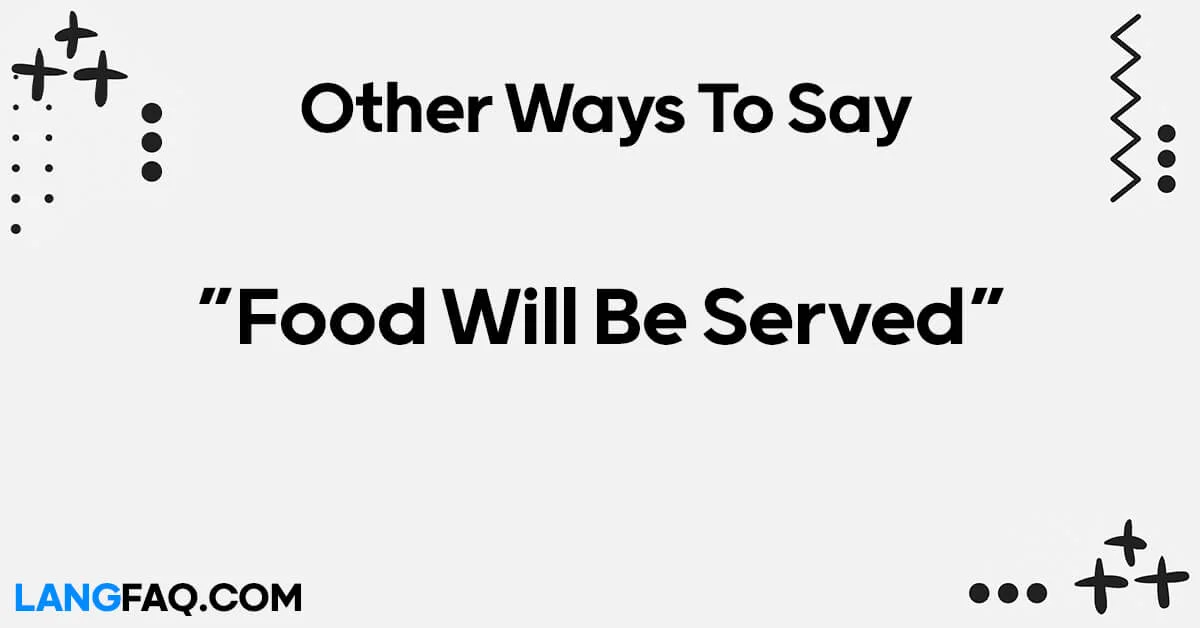Welcoming guests to a meal is more than just a formality; it sets the tone for the entire dining experience. Instead of sticking to the same old phrase, why not sprinkle some variety into your language? In this article, we’ll explore twelve creative alternatives to the common statement “food will be served.” Whether you’re hosting a formal dinner party or a casual get-together, these expressions will add a touch of sophistication and flavor to your announcements. Let’s dive in and elevate your dining etiquette!
12 Other Ways to Say “Food Will Be Served”
Here are 12 alternative ways to say “food will be served”:
- “The feast is ready”
- “Dinner is on the table”
- “Time to dig in”
- “The meal awaits”
- “Let’s enjoy the spread”
- “Feast time!”
- “Food is served”
- “Let’s gather for grub”
- “Mealtime is here”
- “Come and get it”
- “The table is set”
- “Bon appétit!”
Here’s a table with meanings and examples for the 12 alternative ways to say “food will be served”:
| Expression | Meaning | Example |
|---|---|---|
| The feast is ready | Indicates that the meal is prepared and ready to be enjoyed | “The feast is ready for our guests to savor.” |
| Dinner is on the table | Signifies that the main meal is served and ready to be eaten | “Dinner is on the table; let’s gather round.” |
| Time to dig in | Invites guests to start eating or indulging in the meal | “Time to dig in and enjoy this delicious spread.” |
| The meal awaits | Implies that the food is prepared and waiting to be enjoyed | “The meal awaits; let’s not keep it waiting.” |
| Let’s enjoy the spread | Encourages guests to appreciate and enjoy the variety of food available | “Let’s gather and enjoy the spread together.” |
| Feast time! | Excitedly announces that it’s time to feast or enjoy a meal | “Feast time! Let’s celebrate with good food.” |
| Food is served | Simple and direct announcement that the food is ready to be eaten | “Food is served; let’s eat!” |
| Let’s gather for grub | Informal invitation to come together and eat | “Let’s gather for grub and good company.” |
| Mealtime is here | Indicates that it’s time to eat or enjoy a meal | “Mealtime is here; let’s sit down and enjoy.” |
| Come and get it | Invites guests to help themselves to the food | “Come and get it; there’s plenty for everyone.” |
| The table is set | Signifies that everything is prepared and arranged for the meal | “The table is set; let’s begin our meal.” |
| Bon appétit! | French expression wishing guests a good appetite before eating | “Bon appétit! Enjoy your meal.” |
Conclusion:
Using diverse expressions to announce that “food will be served” adds variety and excitement to mealtime announcements. Whether formal or informal, these phrases enhance the dining experience and set a welcoming tone for guests. So, next time you’re hosting a meal, consider using one of these alternatives to make the announcement memorable and enjoyable for everyone.
Is It Correct to Say “Food Will Be Served”?
Yes, “Food will be served” is a correct and grammatically sound way to announce that a meal will be provided or offered to guests. This phrase is commonly used in various settings, such as restaurants, events, or formal gatherings, to indicate that the food is prepared and ready to be served to the guests. It effectively communicates the idea that the meal will be available for consumption at a specified time or location.
In terms of grammar, the sentence follows a simple subject-verb-object structure:
- Subject: “Food”
- Verb: “will be served”
- Object: (implied) unspecified recipients or guests
Overall, “Food will be served” is a clear and concise way to convey the message that a meal will be provided, making it a commonly used phrase in hospitality and event planning contexts.
Professional Mail Example With “Food Will Be Served”
Subject: Reminder: Food Will Be Served at Tomorrow’s Meeting
Dear [Recipient’s Name],
I hope this email finds you well. I wanted to send a quick reminder about our upcoming meeting scheduled for tomorrow [date] at [time] in [location].
As part of our meeting agenda, I’m pleased to inform you that food will be served to all attendees. We have arranged for a selection of refreshments and light snacks to be available throughout the duration of the meeting to ensure everyone’s comfort and sustenance.
Please arrive a few minutes early to grab a bite and settle in before we commence our discussions. If you have any dietary restrictions or preferences that we should be aware of, please don’t hesitate to let us know so that we can accommodate your needs accordingly.
I look forward to seeing you tomorrow and having a productive and engaging meeting. If you have any questions or concerns in the meantime, feel free to reach out to me.
Thank you for your attention, and see you soon!
Best regards,
[Your Name] [Your Position/Title] [Your Contact Information]
The Feast Is Ready
In both formal and informal settings, the phrase “The feast is ready” sets an anticipatory tone, indicating that a delicious meal awaits. It’s a versatile expression suitable for various occasions, from formal dinners to casual gatherings.
Scenario: Formal Dinner Party
At a formal dinner party, the host may use this phrase to announce that the meal is prepared and guests can begin dining. It adds an elegant touch to the evening and sets expectations for a sumptuous feast.
Example Sentence: “Ladies and gentlemen, the feast is ready to be served. Please take your seats and enjoy the culinary delights prepared for you tonight.”
Variation for a Mentor-Mentee Context: “Students, the feast is ready for us to enjoy together. Let’s gather around and celebrate our hard work with a delicious meal.”
Scenario: Casual Family Gathering
Even in a relaxed setting like a family dinner, “The feast is ready” can build excitement and bring everyone together around the table.
Example Dialogue Snippet:
- Parent: “Kids, dinner’s ready!”
- Child: “Yay! The feast is ready! I’m hungry!”
Variation for Friends: “Hey guys, the feast is ready! Let’s dig in and enjoy our meal together.”
Dictionary Insight: According to Cambridge Dictionary, a feast refers to “a special meal with very good food or a large meal for many people.” It’s often associated with celebration and abundance.
Pros: Creates a sense of anticipation and excitement. Adds a touch of formality or elegance to the announcement.
Cons: May sound too formal for very casual gatherings.
Tips: Use this phrase for occasions where the meal is the highlight of the event, such as holiday dinners or celebrations.
Email Sample:
Subject: Dinner Announcement for Saturday Night Gathering
Dear Guests,
I’m delighted to inform you that the feast is ready for our Saturday night gathering! Please join us at [address] at [time] for an evening of delicious food and great company. Looking forward to seeing you there!
Best regards, [Your Name]
Dinner Is on the Table
“Dinner is on the table” is a straightforward and casual way to let guests know that the meal is ready to be enjoyed. It’s perfect for informal gatherings and family meals where simplicity and warmth are valued.
Scenario: Family Dinner
In a family setting, this phrase can be used to gather everyone around the table and signal that it’s time to eat. It conveys a sense of homeliness and togetherness.
Example Sentence: “Kids, dinner is on the table! Wash your hands and come sit down.”
Variation for Colleagues: “Team, dinner is on the table in the break room. Let’s take a break and enjoy our meal together.”
Dictionary Insight: According to Merriam-Webster, dinner refers to “the principal meal of the day.” In many cultures, it’s a time for family or community to come together and share a meal.
Pros: Simple and straightforward. Suitable for various casual settings.
Cons: May lack the elegance or formality desired for certain occasions.
Tips: Use this phrase when informality and warmth are valued, such as family dinners or casual gatherings with friends.
Email Sample:
Subject: Dinner Announcement for Family Gathering
Hi everyone,
Just a quick note to let you know that dinner is on the table! Come to the dining room when you’re ready to enjoy a delicious meal together. Can’t wait to catch up and share some good food!
Warm regards, [Your Name]
Time to Dig In
“Time to dig in” is a casual and friendly way to invite guests to start eating. It conveys a sense of informality and encourages everyone to enjoy the meal together.
Scenario: BBQ Party
At a backyard BBQ party, the host might use this phrase to signal that the food is ready to be enjoyed. It sets a relaxed and laid-back atmosphere, perfect for mingling and feasting.
Example Dialogue Snippet:
- Host: “Alright everyone, the burgers and hot dogs are grilled to perfection. Time to dig in!”
- Guests: “Yum! Let’s grab a plate and dig in!”
Variation for Friends: “Hey guys, the pizza’s here! Time to dig in and enjoy some slices.”
Dictionary Insight: The phrase “dig in” is informal and colloquial, meaning to start eating eagerly or enthusiastically.
Pros: Encourages a casual and relaxed atmosphere. Invites guests to enjoy the meal together without formality.
Cons: May be too informal for certain settings or occasions.
Tips: Use this phrase for informal gatherings where the emphasis is on enjoying good food and company.
Email Sample:
Subject: BBQ Party Announcement
Hey everyone,
Just a quick heads up – the grill is fired up and the food is ready! It’s time to dig in and enjoy some delicious BBQ. See you all in the backyard!
Cheers, [Your Name]
The Meal Awaits
When “The meal awaits,” it suggests that the food is prepared and waiting for guests to start eating. It’s a versatile phrase suitable for various settings, from formal dinners to casual get-togethers.
Scenario: Dinner Party
At a formal dinner party, the host might use this phrase to announce that the main course is ready to be served. It adds a touch of elegance and anticipation to the dining experience.
Example Sentence: “Ladies and gentlemen, the meal awaits. Please take your seats, and our servers will begin serving shortly.”
Variation for Colleagues: “Team, the meal awaits in the conference room. Let’s take a break from our meeting and enjoy some food together.”
Dictionary Insight: According to Oxford Languages, the word “await” means to wait for (someone or something) or to be waiting for (someone or something).
Pros: Conveys anticipation and readiness for the meal. Suitable for both formal and informal settings.
Cons: May sound slightly formal for very casual gatherings.
Tips: Use this phrase when you want to build anticipation and set the stage for an enjoyable dining experience.
Email Sample:
Subject: Dinner Announcement for Saturday Night Gathering
Dear Guests,
I’m pleased to announce that the meal awaits at our Saturday night gathering! Please join us at [address] at [time] for an evening of fine dining and delightful company. We can’t wait to share this meal with you.
Warm regards, [Your Name]
Let’s Enjoy the Spread
Inviting guests to “enjoy the spread” is a friendly and inclusive way to encourage them to appreciate the variety of food available. It emphasizes the abundance and diversity of dishes on offer.
Scenario: Potluck Dinner
At a potluck dinner, the host might use this phrase to welcome guests and invite them to sample the different dishes brought by attendees. It creates a communal atmosphere and encourages everyone to try a bit of everything.
Example Sentence: “Welcome, everyone! Let’s enjoy the spread and savor the delicious dishes contributed by our guests.”
Variation for Friends: “Hey everyone, the potluck spread looks amazing! Let’s grab a plate and enjoy the delicious food together.”
Dictionary Insight: The term “spread” refers to a selection of food laid out on a table or buffet for people to serve themselves from.
Pros: Highlights the variety and abundance of food available. Encourages guests to try different dishes and share in the culinary experience.
Cons: May be less suitable for formal or upscale events.
Tips: Use this phrase for casual gatherings where guests contribute dishes, such as potluck dinners or buffet-style parties.
Email Sample:
Subject: Potluck Dinner Reminder
Hi everyone,
Just a friendly reminder that our potluck dinner is tonight! We’re looking forward to enjoying the spread of delicious dishes that everyone will bring. See you all there!
Best, [Your Name]
Feast Time!
“Feast time!” is an enthusiastic and celebratory announcement that it’s time to indulge in a delicious meal. It sets a festive tone and invites guests to enjoy the abundance of food before them.
Scenario: Holiday Feast
At a holiday feast, such as Thanksgiving or Christmas dinner, the host might use this phrase to kick off the meal and get everyone excited about the delicious spread laid out on the table.
Example Dialogue Snippet:
- Host: “Alright everyone, feast time! Let’s gather around the table and give thanks for this wonderful meal.”
- Guests: “Yay! Feast time! I can’t wait to dig in!”
Variation for Family Gatherings: “Kids, it’s feast time! Let’s all sit down and enjoy our meal together.”
Dictionary Insight: A feast is a large, elaborate meal, typically prepared for a special occasion or celebration.
Pros: Sets a festive and celebratory tone. Builds excitement for the meal.
Cons: May be too informal for very formal events.
Tips: Use this phrase for celebratory occasions where the meal is the centerpiece of the event, such as holiday dinners or special gatherings.
Email Sample:
Subject: Thanksgiving Dinner Invitation
Dear Friends and Family,
You’re invited to join us for Thanksgiving dinner this year! It’s going to be feast time with plenty of delicious food and great company. We can’t wait to celebrate with you all!
Warm regards, [Your Name]
Food Is Served
The simple and direct phrase “Food is served” is a classic way to announce that the meal is ready to be enjoyed. It’s versatile and can be used in both formal and informal settings.
Scenario: Formal Event
At a formal event, such as a wedding reception or gala dinner, the catering staff might use this phrase to indicate that the main course is ready to be served to guests. It’s concise and signals that it’s time to begin dining.
Example Sentence: “Ladies and gentlemen, food is served. Please enjoy your meal.”
Variation for Colleagues: “Team, food is served in the banquet hall. Let’s take a break from the presentations and enjoy our lunch.”
Dictionary Insight: According to Merriam-Webster, “serve” means to provide food or drink to guests, customers, or diners.
Pros: Clear and straightforward. Suitable for various formal occasions.
Cons: May lack excitement or warmth compared to more elaborate announcements.
Tips: Use this phrase when you want to make a straightforward announcement without embellishment, such as at formal events or professional gatherings.
Email Sample:
Subject: Dinner Announcement for Company Event
Dear Team,
I’m pleased to inform you that dinner is served at our company event tonight. Please make your way to the dining area to enjoy a delicious meal together. Bon appétit!
Best regards, [Your Name]
Let’s Gather for Grub
Using the phrase “Let’s gather for grub” is a fun and informal way to invite people to come together and enjoy a meal. It adds a touch of playfulness to the dining experience and encourages camaraderie.
Scenario: Casual Gathering
At a casual gathering with friends or colleagues, the host might use this phrase to invite everyone to gather around and enjoy some food together. It sets a relaxed and laid-back tone for the meal.
Example Sentence: “Hey everyone, let’s gather for grub in the kitchen. I’ve got some snacks and drinks ready to go.”
Variation for Friends: “Guys, the pizza’s here! Let’s gather for grub in the living room and catch up.”
Dictionary Insight: “Grub” is a colloquial term for food, especially when served in large quantities.
Pros: Informal and playful. Encourages a sense of togetherness and camaraderie.
Cons: May be too casual for formal events or professional settings.
Tips: Use this phrase for informal gatherings with friends or colleagues where the emphasis is on having fun and enjoying each other’s company.
Email Sample:
Subject: Informal Lunch Gathering
Hi everyone,
I’m planning an informal lunch gathering in the break room tomorrow. Let’s gather for grub and enjoy some good food together. Feel free to bring any snacks or drinks you’d like to share!
See you there, [Your Name]
Mealtime Is Here
Announcing that “Mealtime is here” is a straightforward yet warm way to let everyone know that it’s time to sit down and enjoy a meal together. It’s suitable for various settings, from family dinners to casual get-togethers.
Scenario: Family Dinner
In a family setting, especially with children, this phrase can be used to gather everyone around the table and signal that it’s time to eat. It creates a sense of routine and anticipation for the meal ahead.
Example Sentence: “Kids, mealtime is here! Let’s wash up and gather around the table for dinner.”
Variation for Colleagues: “Team, mealtime is here. Let’s take a break from work and enjoy some lunch together in the break room.”
Dictionary Insight: According to Cambridge Dictionary, “mealtime” refers to the usual time when a meal is eaten.
Pros: Simple and direct. Suitable for various informal settings.
Cons: May lack excitement or flair compared to more elaborate announcements.
Tips: Use this phrase when you want to make a straightforward announcement without too much fanfare, such as for family dinners or casual gatherings.
Email Sample:
Subject: Dinner Announcement for Family Gathering
Hi everyone,
Just a quick reminder that mealtime is here! Let’s gather around the table in the dining room and enjoy a delicious meal together as a family. Can’t wait to see you all there!
Best, [Your Name]
Come and Get It
“Come and get it” is a casual and inviting way to announce that the food is ready to be served or enjoyed. It’s often used in informal settings to encourage guests to help themselves to the meal.
Scenario: BBQ Party
At a backyard BBQ party, the host might use this phrase to signal that the food is ready to be enjoyed and that guests can help themselves to the dishes laid out on the buffet table.
Example Dialogue Snippet:
- Host: “Alright everyone, come and get it! The burgers and hot dogs are ready to be served.”
- Guests: “Yum! Let’s grab a plate and come and get it!”
Variation for Friends: “Hey guys, the pizza’s here! Come and get it before it gets cold.”
Dictionary Insight: According to Merriam-Webster, the phrase “come and get it” is used to invite someone to come and take what is being offered.
Pros: Informal and inviting. Encourages guests to help themselves to the meal.
Cons: May be too casual for very formal events or professional settings.
Tips: Use this phrase for informal gatherings where guests are encouraged to serve themselves, such as BBQs or buffet-style parties.
Email Sample:
Subject: Dinner Announcement for Casual Get-Together
Hey everyone,
Just wanted to let you know that dinner’s ready! Come and get it in the kitchen, and let’s enjoy a casual meal together. Can’t wait to catch up!
Cheers, [Your Name]
The Table Is Set
Announcing that “The table is set” is a traditional and formal way to signal that everything is prepared and arranged for the meal. It’s often used in formal settings to indicate that guests can take their seats and begin dining.
Scenario: Formal Dinner Party
At a formal dinner party or event, the host or hostess might use this phrase to announce that the table is ready for guests to sit down and enjoy the meal. It adds an air of elegance and sophistication to the dining experience.
Example Sentence: “Ladies and gentlemen, the table is set. Please take your seats, and our servers will begin serving shortly.”
Variation for Colleagues: “Team, the table is set in the dining room. Let’s gather for our business lunch meeting.”
Dictionary Insight: According to Oxford Languages, “set” in this context means to arrange or prepare something, especially a table or a meal, for eating or serving.
Pros: Formal and elegant. Sets expectations for a well-prepared and organized meal.
Cons: May be too formal for very casual gatherings.
Tips: Use this phrase for formal events or dinners where a sense of ceremony and elegance is desired.
Email Sample:
Subject: Dinner Announcement for Formal Event
Dear Guests,
I’m delighted to announce that the table is set for our formal dinner event tonight. Please join us in the dining hall at [time] for an evening of exquisite cuisine and delightful conversation. We look forward to welcoming you.
Warm regards, [Your Name]
Bon Appétit!
The French expression “Bon appétit!” is a classic and elegant way to wish guests a good appetite before they start eating. It’s commonly used in formal and informal settings to express good wishes for the meal ahead.
Scenario: Dinner Party
At a dinner party or gathering, the host might use this phrase to wish guests well before they begin eating. It adds a touch of sophistication and hospitality to the dining experience.
Example Sentence: “Bon appétit, everyone! Enjoy your meal and the company of good friends.”
Variation for Friends: “Hey guys, dinner’s served! Bon appétit! Let’s dig in and enjoy.”
Dictionary Insight: According to Collins Dictionary, “bon appétit” is a French phrase that translates to “good appetite” in English and is used to wish someone a hearty appetite before a meal.
Pros: Elegant and sophisticated. Adds a touch of international flair to the dining experience.
Cons: May be less commonly used in some English-speaking cultures.
Tips: Use this phrase to add a touch of elegance and hospitality to formal or informal dining occasions.
Email Sample:
Subject: Dinner Invitation for Friends
Hi everyone,
Just a quick note to let you know that dinner’s ready! Bon appétit! Come over to [address] whenever you’re ready to enjoy a delicious meal and some great company.
Cheers, [Your Name]
Frequently Asked Questions (FAQs)
How can I make my dining announcements more engaging? To make your dining announcements more engaging, try incorporating creative and descriptive language that sets the tone for the dining experience. Consider using phrases that evoke anticipation and excitement, inviting guests to savor the moment.
What are some formal alternatives to “food will be served”? Formal alternatives to “food will be served” include expressions such as “the banquet awaits” or “the table is set, let’s feast.” These phrases add an air of sophistication and elegance to your dining announcements.
Are there casual ways to announce that food will be served? Yes, there are casual ways to announce that food will be served. Phrases like “time to tuck in” or “let’s dig in” create a relaxed and informal atmosphere, perfect for casual gatherings or family meals.
How can I enhance the dining experience for my guests? To enhance the dining experience for your guests, pay attention to details such as ambiance, presentation, and variety in the menu. Consider incorporating themed decorations or background music to set the mood and create a memorable experience.
What role does language play in dining etiquette? Language plays a crucial role in dining etiquette as it sets the tone for the entire dining experience. Using polite and inviting language helps guests feel welcomed and sets the stage for an enjoyable meal.
How can I incorporate these expressions into my next event? You can easily incorporate these expressions into your next event by incorporating them into your invitations, menu cards, or verbal announcements. Choose phrases that resonate with the tone and theme of your event to create a cohesive experience for your guests.
Conclusion
Incorporating diverse and engaging language into your dining announcements can elevate the entire experience for you and your guests. By exploring alternative ways to say “food will be served,” you can add flair and personality to your gatherings while setting the stage for a memorable meal. So, whether you’re hosting a formal dinner party or a casual get-together, let your language reflect the warmth and hospitality of your hospitality.







